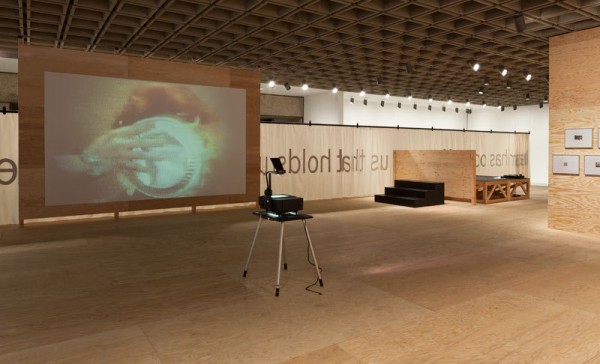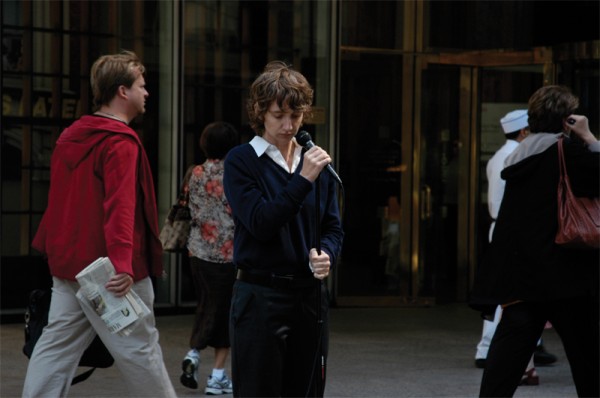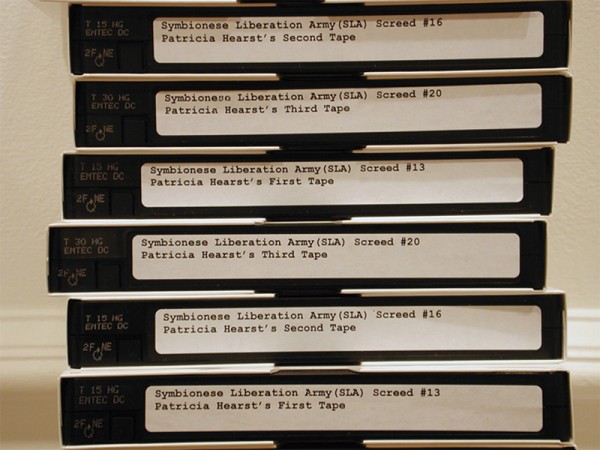-
There’s So Much I Want to Say to You
by Rachel Wetzler September 3, 2012

Installation view of ‘There’s so much I want to say to you.’ Photograph by Sheldan C. Collins.
It is an appropriate moment for Sharon Hayes’s solo exhibition There’s So Much I Want to Say to You, a year when modes of “public address” — the framework that has anchored her work for the past decade — have come to the fore. Her work often employs the “official” language of politics (campaign slogans, speeches), on the one hand, and that of protest on the other, two conceptions of the public and the political that are at once inextricably linked and diametrically opposed. With the convergence of an election year and the widespread Occupy protests — whose own slogans have quickly become a part of the vernacular — in 2012, an examination of political speech seems apropos, even necessary.
In spite of the timeliness of her current exhibition, Hayes’s practice is rarely about a specific event in itself. Rather, her work — which she describes as “speech acts” — is largely concerned with historical memory as explored through the lens of the language of politics, emphasizing the points of continuity and change. As Hayes notes in an artist’s statement, her work conceives of the political present as one that is “always allegorical, a moment that reaches simultaneously backwards and forward.”
In lieu of multiple galleries with labels delineating discrete works, the exhibition takes the form of a single, large-scale multimedia installation spanning the entirety of the Whitney’s third floor. Much of the space is taken over by a large-scale plywood platform throughout which she has placed various video, audio, and photo-based works, several of which were created specifically for the show. Designed in collaboration with artist Andrea Geyer, the platform was meant, according to the two, to recall a trade show or rally — temporary, ad hoc structures where various attractions and voices compete for attention, intended to counter the assumed sterility of the museum setting and its impression of quiet refinement. Viewers must move around and throughout Hayes and Geyer’s installation to see everything: several works are tucked into corners, or given their own small, semi-intimate nooks for sitting and watching projections or listening to audio pieces.

Sharon Hayes’ ‘Everything Else Has Failed! Don’t You Think It’s Time For Love?,’ 2007. Photograph by Andrea Geyer. Courtesy the artist and Tanya Leighton Gallery, Berlin.
Yet, the apparent nod to interactivity seems overstated: despite the somewhat nontraditional arrangement, sitting in a gallery with headphones on is hardly a radical form of engagement, nor a democratization of the gallery space. In spite being rooted in the public sphere, Hayes’s work does not necessarily lend itself to participation, although the process of creating is often collaborative: her strongest works are those that most directly address the intersections between the personal and the political, in which she is directly present, addressing her audience in the first person. While the material she probes harks back to identity politics — gay liberation, AIDS activism, the women’s movement, Black Power — the “I” in her work can never be directly identified as the artist herself. Hayes is not concerned with an examination of her own individual identity or subjective experience, and many of the events she references are pulled from well before the artist reached maturity, in some cases before she was even born. Rather, the dissonance between the words themselves and the person who speaks them, or between the urgency of the messages of past moments and their evocation in the present, serves to disrupt the continuity of historical memory, forcing viewers to consider the language itself, divorced from its familiar contexts.
In the audio installations Everything Else Has Failed! Don’t You Think It’s Time for Love? (2007) and I March in the Parade of Liberty, But As Long As I Love You I am Not Free (2007-08), both of which originated as public performances, Hayes delivers first-person love letters that merge the language of political protest with that of individual desire. The former was initially delivered outside the corporate headquarters of UBS, addressed to an unnamed lover from whom the author had been separated; the latter employed gay liberation slogans alongside fragments from sources such as Oscar Wilde’s De Profundis and newspaper coverage of early gay rights protests. Intentionally conflating public and private by delivering ostensibly “personal” correspondence in the streets, she highlights the uneasy divide between the two spheres, particularly concerning gay and women’s rights, in which the most intimate aspects of one’s life are points of political contention. Desire is recoded as a political category, embodied by the demands of protest.
This intersection between performance and speech is plainly Hayes’s strength, and the works in which she is most absent also tend to be the exhibition’s weakest: an overhead projector beams a still image of the face of notorious homophobe Anita Bryant covered in cream pie, the result of a protest by gay activists, or a selection of found “before” photographs, framed and placed on a wall within the installation, meant to — according to a pamphlet at the exhibition’s entrance — metaphorically chart the progression of a suburban housewife into a radical activist. Arrangements of decades-worth of record covers lining the gallery’s perimeter, all from the artist’s personal collection, provides notable insight into her process and influences, but does little as a work of art in itself. Likewise, Join Us, a wall-sized grid of political flyers announcing protests and public actions, from the Vietnam War-era to Occupy Wall Street, forms a fascinating document of the history of American dissent, but its appeal is derived the power of the material itself, not Hayes’s treatment of it. Such moments left the impression that Hayes, for her most significant exhibition to date, felt compelled to fill the space: to give her audience something to look at. Indeed, in spite of her apparent desire to subvert the traditional museum exhibition format, these static, wall-bound pieces seemed most aligned with traditional gallery fare. They pale in comparison to Hayes’s arresting performance-based projects, whose impact is largely drawn from what is said rather than what is seen.

Hayes’ ‘Symbionese Liberation Army (SLA) Screeds #13, 16, 20 & 29,’ 2003. Installation detail. Courtesy the artist and Tanya Leighton Gallery, Berlin.
The exhibition’s obvious high point is one such work, a small sub-room within the installation, playing Hayes’s Symbionese Liberation Army (SLA) Screeds #13, 16, 20, & 29 (2003), one at a time. In them, we see a close-up of the artist’s face, staring directly at the camera against a plain white wall, as she attempts to recite the transcripts of tapes sent by Patty Hearst to her parents while kidnapped by the SLA. The charged language of the screeds, political demands and denunciations interspersed with a daughter’s distress at her family’s apparent disregard for her circumstances, is abstracted in the videos, as Hayes stumbles over the words, visibly struggling to recall her lines. She is assisted by a group of people offscreen who correct her when she makes mistakes, jarring interruptions that prevent any notion of identifying the speaker we see — Hayes — with the author of the communiqué she delivers. Elsewhere, Hayes has displayed this piece as an installation, surrounded by piles of black VHS tapes for the visitor to take, but the intimacy of the presentation here works in its favor; the room created for the SLA Screeds is tight, claustrophobic even, with the viewer confronted directly with the artist’s face, wincing as she butchers the text.
Hayes’s notion of her work as “speech acts” is, of course, a reference to the work of linguist J.L. Austen, whose How to Do Things With Words argued that certain forms of language — what he termed “performative utterances” — had the capacity to not only articulate or describe, but to enact, as in an officiant who marries a couple or a judge who delivers a prison sentence. In Hayes’s work, the idea of “speech acts” takes on a twofold meaning: she calls attention to the potential of language in its ability to shape the social and political landscape, but also uses language actively, temporarily recalling past moments through her performance of their linguistic traces.
‘Sharon Hayes: There’s So Much I Want to Say to You’ runs at the Whitney Museum of American Art, 945 Madison Avenue, through September 9.


